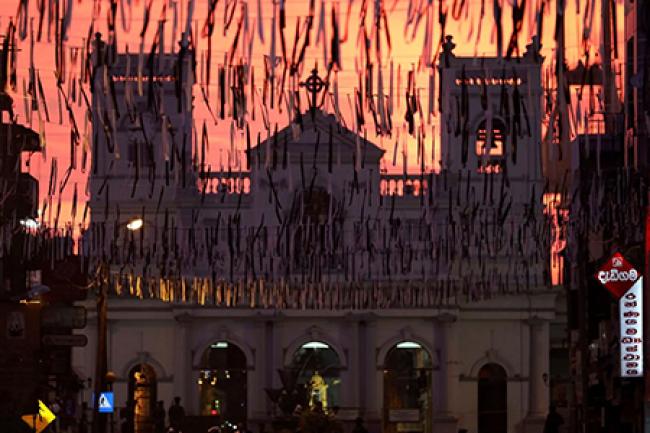
On the evening of April 20, I was making Easter bread with my children at our home in California when a friend texted me, saying there had been bombings in Sri Lanka. My chest hurt. I thought, I have been there before. I grew up partly in northern Jaffna, one of the major battlefields of the Sri Lankan civil war. Over the conflict’s three decades, most Sri Lankans lost someone to death or disappearance — in my case, my mother. News like this does not initiate a new fear: It ignites an old one, based on myriad experiences of explosions and of fearing the worst. The trauma has lingered, waiting to be revived, the emotions entangling themselves with new experiences.
Over the past week, people have repeatedly asked me what it means to be a Sri Lankan Christian, and how the Easter Sunday attacks relate to Christian communities — a line of inquiry that links us not to other Sri Lankans but to other Christians around the world. I answer slowly, carefully, attempting to be precise. In Sri Lanka, I say, people are making an effort to grieve across community and ethnicity. Churches and clergy have issued statements not only condemning the violence but also warning against any retaliation against minority Muslim communities that might follow. We have already seen isolated incidents of such violence. We fear more will follow.
My interlocutors rarely find this satisfying. Just this week, an undergraduate at the university where I teach sent me an email accusing me of dismissing the existence of a global war on Christianity. She found my insistence on Sri Lankan specificity frustrating; she wanted to grieve, too. Some outside observers, including Vice President Pence, were quick to frame the attacks in these terms. But Sri Lanka’s ethnic and religious life is often fraught, sometimes violent and always intimate, in ways that defy easy answers. The attacks themselves are evidence of this: Although the bombings in the two major Catholic churches occurred during the Tamil-speaking service, many of the dead are Sinhalese. The pastor at the Zion Evangelical Church in Batticaloa, who lost his son, recalled welcoming the bomber in when he saw him: Many Muslims came to the service for healing.
Even a basic attempt to convey Sri Lanka’s demographics grows complicated quickly. Sri Lanka is divided between Sinhala and Tamil speakers. The Sinhala speakers mainly comprise one ethnic group, the Sinhalese, and are predominantly Buddhist, with a small Christian minority. The Tamil speakers are composed of many ethnic minorities, including Sri Lankan Muslims, Sri Lankan Tamils and Hill-Country Tamils. (There are also minorities who belong to neither group — Dutch and Portuguese burghers, for example.) Among Sri Lankan Tamils, the community I belong to, the majority are Hindu, and 15 percent are Christians of various denominations. In Sri Lanka, Christians are not their own clear-cut minority group but, instead, are defined in relation to their ethnic group, the language that they speak and their denominations.
The civil war was a decades-long assault on our coexistence, and left scars that remain evident today. The Sri Lankan state and the Liberation Tigers of Tamil Eelam (LTTE) targeted dissidents and members of other ethnic communities, and indiscriminately bombed places of worship, hospitals and public transport. In the name of security, both sides conducted arrests and maintained forms of surveillance that continually violated human rights. They violently provoked tensions between Tamil and Muslim minorities, who share the same language. In May, we will mark the 10th anniversary of the war’s end, which arrived after three failed peace processes and killed at the minimum 40,000 Tamils in its final four months. There have been no effective reconciliation processes since then. Unaddressed deaths and disappearances, our ghosts, lie close. Ethnic tensions linger, as has the militarization of everyday life. Watching the burials of those killed on Easter Sunday, I thought of the thousands of bodies never recovered and the people who their families had to symbolically bury, cremate, imagine and never forget, those whose bodies never returned home. We have been here before, I thought.
As the aftermath of the attacks has unfolded, my friends and family and I struggled to make sense of them. Since the end of the war, which had elevated ethnicity as the defining difference, there has been rising religious hostility. Still, even in a country that has seen many bombings and many suicide attacks, these events took us by surprise. They seemed to have erupted out of context, without any obvious connections to the history with which we were familiar.
The bombings marked a sharp break from old forms of violence. They were highly coordinated, well-organized attacks on an order that even the LTTE had not ventured in its heyday. While places of worship were bombed during the war, tourists or hotels were rarely targets. While there have been incidents of religious violence over the past several years, including against Christians, the vast majority have been against Muslim communities. The perpetrators have typically been radical monk orders backed by the state. ISIS and similar organizations haven’t had nearly as large a presence, or as long a history, in Sri Lanka — we only knew of the small, shallowly rooted groups such as the National Thowheed Ja’maath, which had been expelled from local mosques and communities.
On Easter Sunday, memories flooded over me, as they have every evening since as I’ve tried to fall asleep, dry-eyed and heart heavy. In Sri Lanka, churches, temples and mosques are not only places of prayer and politics, but also of shelter and care. When I was growing up, during the war, they housed displaced communities — sometimes overnight, and sometimes for months at a time — and were themselves shelled. Places of worship always opened their doors to those of other faiths. I remember fashioning crosses out of palms as a child at my Tamil Protestant church and processing through the streets of Jaffna singing on Palm Sunday. Kneeling and listening to sermons and hearing the liturgy sung in Tamil, when I conducted research with Catholic communities. Breaking fast with Muslim friends in the evenings at Ramadan. Seeing the small Buddha in my paternal grandmother’s room, always with offerings of flowers, freshened daily. Taking my children to the big Hindu temple near our home in Jaffna for the temple festival in August, just as I was taken as a child. Even amid the violence between our communities, we are practiced at inhabiting each other’s religious experiences. The everyday, overlapping sounds of the call to prayer, the church bells, the chanting of the Buddhist temple and the morning bells from Hindu temples, acknowledge this constantly.
READ THE REST OF THE ARTICLE HERE.
Originally published on April 30, 2019 in The Washington Post
